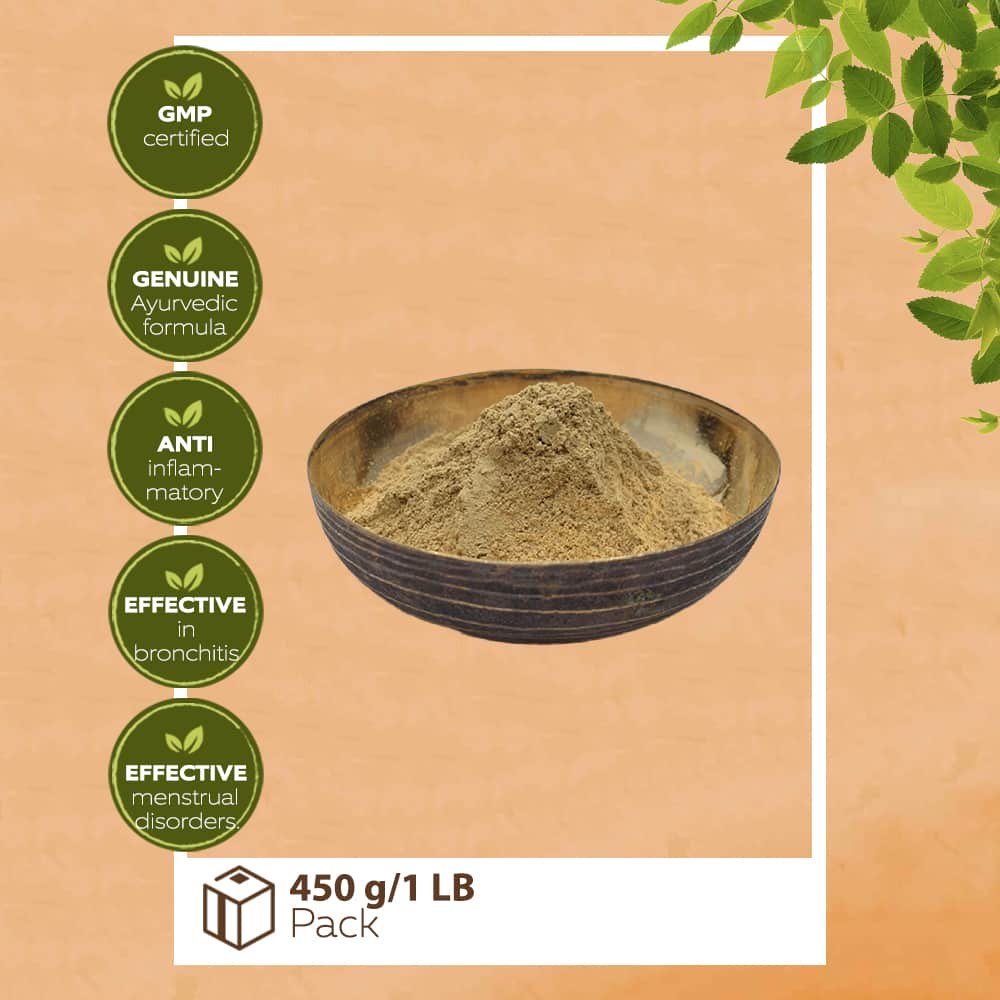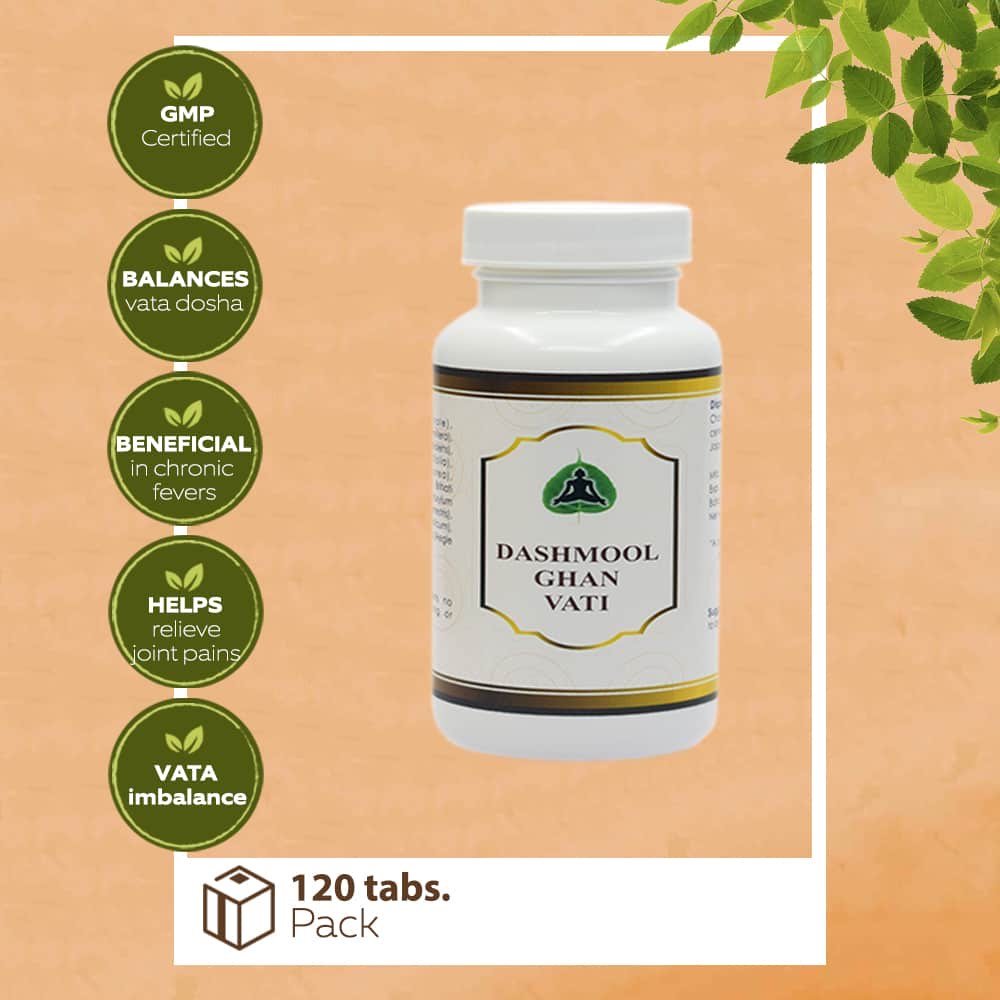

What is Dashmool?
Dashmool literally means “ten roots” referring to the traditional ingredients of the formula. Dashmool is a traditional Ayurvedic formula for removing excess vata from the system. It is a nourishing muscle tonic that strengthens the body and calms the nerves. Dashmool promotes healthy expectoration and respiration while supporting the proper function of the lungs and nervous system.
Key Benefits :

Nervous System Support:
Alleviates vata imbalance, treats sciatica, tremors, and nervous disorders.Vatasamana pacifies vata and nervous system

Respiratory Health:
Promotes healthy expectoration and relieves cough, asthma, and bronchitis. Kasasvasahara Alleviates cough and asthma

Reproductive Health:
Beneficial for hormonal disorders, postpartum recovery, and infertility.
Applications:

Internal Use:
It used for the internal conception, as well as in the treatment of enemas, consisting of medicinal oils.

Special therapies:
The whole herbs is used as an enema to eliminate natural toxins from the GI tract and to balance vata in the lower region of the body.

external Use:
Therapeutic massage oils are made & also used in the form of tea to treat certain conditions. Dashmool oil is easily applied to various parts of the body as a complete healing massage. caused by vata and kapha
Key Ingredients:
Bilva ( Aegle marmelos)
Just like Tulsi plant is sacred to Lord Krishna and Durva grass is sacred to Lord Ganesha, Bilva tree is sacred to Lord Shiva. Since the Bilva leaf has such significance in the worship of Lord Shiva, it is common to find Bilva trees cultivated in the vicinity of Shiva temples.
Properties- Bilva is astringent and bitter in taste , pungent in the post digestive effect and has hot potency . It alleviates kapha and vata dosas, but aggravates the pitta dosa. It has astringent, anti-diarrhoeal, appetizer and digestant properties. The raw fruit is an appetizer, digestant and an astringent, whereas the ripened fruit is astringent, sweet but mild laxative in properties. The ripened fruit is heavy to digest and in large doses, it causes flatulence and abates peristalsis. Bilva possessed dry an light attributes.
Root– A preparation made from the root with ginger and toasted rice cures vomiting. For the treatment of piles, dysentery and diarrhoea, a preparation is made from the root mixed with another tuberous root. The oil extracted from the Bilva root, boiled with the juice of Bilva leaves and applied to the head is excellent for nasal catarrh and diseases of the ear.
Agnimantha (Premna integrifolia)
It is a good anti-vata herbal remedy, is useful for edema and degenerative disorders.
Properties:
1.Rasa (taste): Tikta (bitter), Katu (pungent), Kashaya (astringent), Madhura (sweet)
2.Guna (quality): Laghu (light), Ruksha (dry)
3.Virya (energy): Ushna (heating)
4.Vipaka (post digestive effect): Katu (pungent)
Uses: Thermogenic, anodyne, antiinflammatory, alexeteric, expectorant, febrifuge, galactogogue, depurative, laxative, digestive, liver stimulant, carminative, cardiac stimulant, cardio tonic, antibacterial, tonic & useful in cough, cold, asthma, bronchitis, anorexia, constipation, hepatopathy, neuralgia, haemorrhoids, fever, diabetes, agalactia, colic & tumour etc.
Shyonaka (Oroxylum indicum)
The common name ‘midnight horror’ is probably in reference to the fact that the flowers tend to open at night and have a distinctly foul smell.
Properties and Uses-Rasa: madhura tikta, kashaya, katu (root); tikta, katu, kashaya (bark); madhura, kashaya (unripe fruit); madhura, katu (ripe fruit)
Vipaka: katu
Virya: shita
Shyonaka root is perhaps best known as an ingredient the Dashamula or ‘ten roots’ formula, but is also found in the famous confection Chyavanaprash, and Narayana taila.Shyonakaroot, bark and leaf is an important remedy for inflammation of the digestive tract, such as vomiting, ulceration or diarrhea, used by itself as the freshly collected bark juice or a cold infusion of the root bark powder.
Patala (Stereospermym suaveolens)
Tikta ; Kashaya, madhura
Guna: Guru
Veerya:Usna, Anusna
This is a middle sized flowering tree, a native of Bengal. The flowers are large, of a dark crimson colour and exquisitely fragrant. Steeped in water they impart their fragrance to it. Rubbed up with honey they are given to check hiccup. The root-bark is an ingredient of dasamula ( see Desmodium gangeticum ), and is thus largely used in native medicine. It is regarded as cooling, diuretic and tonic, and is generally used in combination with other medicines. The ashes of this plant are used in the preparation of alkaline water and caustic pastes.
Kashmari (Gmelina arborea)
Properties & Uses-Gmelina arborea is a fast growing tree, mali which though grows on different localities and prefers moist fertile valleys with 750–4500 mm rainfall. It does not thrive on ill-drained soils and remains stunted on dry, sandy or poor soils; drought also reduces it to a shrubby form.
The root and bark of Gmelina arborea are stomachic, galactagogue laxative and anthelmintic; improve appetite, useful in hallucination, piles, abdominal pains, burning sensations, fevers, ‘tridosha’ and urinary discharge. Leaf paste is applied to relieve headache and juice is used as wash for ulcers.
Flowers are sweet, cooling, bitter, acrid and astringent. They are useful in leprosy and blood diseases.The fruit is acrid, sour, bitter, sweet, cooling, diuretic tonic, aphrodisiac, alternative astringent to the bowels, promote growth of hairs, useful in ‘vata’, thirst, anaemia, leprosy, ulcers and vaginal discharge.
The plant is recommended in combination with other drugs for the treatment of snakebite and scorpion sting. In snakebite a decoction of the root and bark is given internally.
Bruhati (Solanum indicum)
PROPERTIES AND ACTION
Rasa : Katu, Tikta
Guna : Laghu
Virya : Ushna
Vipaka : Katu
The herb is specifically used to boost sexual desire, fight diarrhea, stimulate heart and blood circulation, treat meteorism, and resolve body fluids.
The root is particularly useful for inducing perspiration and urination, treating coughs, and stimulating the organism.
The list of conditions in which the herb is applied includes: helminthes, hard urination, toothache, scorpion bites, meteorism, edema, painful and dry coughs, colic, recurrent fevers, chest pains, catarrh, and asthma.
Kantakari root (Solanum xanthocarpum)
GUNA : Ruksha, Laghu ,Tikshan
RASA : Tikt, Katu
VIPAK : Katu
VIRYA : Ushan
PRABHAV : Kashar
The herb itself is known to boost metabolic rates, kill helminthes, relieve stomach conditions, induce expectoration, urination; fight diarrhea, and act as a bitter tonic.
Flowers, fruits, and stems are known to fight flatulence.
The root is used to relieve fevers, induce expectoration, and urination.
Each plant’s part is applied for treating gonorrhea, chest pains, heart conditions, dropsy, flatulence, asthma, coughs, and fevers.
Herb’s root (used as a confection or decoction) is usually prescribed for chest pains, catarrhal fevers, asthma, dropsy, bladder stones, dysuria, and coughs. It is also beneficial in case of enlarged spleen and liver.
The plant belongs to 10 most active root sources in Ayurvedic medicine. Thus, it is highly valued in Indian traditional medicine.
Shalaparni (Desmodium gangeticum)
Shalaparni is sweet in taste and mildy warming in action. It is calming, strengthening and anti-inflammatory. It restores balance to the system when other herbs fail.
Rasa: tikta, madhura
Virya: ushna, guru
Shalaparni Root is commonly used in Ayurvedic medicine as an Anti-inflammatory, Anti-bacterial, Anti-fungal, Anti-pyretic, Spasmolytic, Analgesic, Anti-arthritic. It has other uses as a smooth muscle relaxant, and bronchial muscle relaxant. The leaves and stem of Shalaparni are used in African countries for fevers, skin diseases and anxiety.
Prushniparni (Uraria picta)
PROPERTIES AND ACTION
Rasa : Madhura, Amla, Katu, Tikta
Guna : Laghu, Sara
Virya : Ushna
Vipaka : Madhura
It is an antifungal, it cures pus formation, swelling and pain.Its powder is sprinkled over tuberculoid ulcers or its paste.It is used in painful swelling.
It stimulates brain and nervous system.
It act as cardiac stimulant and blood purifier. Best medicine for cardiac asthma.
Useful in amenorrhoea and dysmenorrhoea.It is useful in skin disorders.
Gokshura (Tribulus terrestris)
Rasa-Madhur
Guna-Guru, Snigdha
Virya-Sheeta
Vipaka-Madhur
It act as analgesic used in neural debility, painful conditions and vata disorders. It is used in low appetite, piles.It is cardiotonic, anti-inflammatory and helps in haemorrhagic disorders.It is used in heart diseases.It is used in cough and asthma.
It is an aphrodisiac and helps in conception, useful in preventing abortion, vaginal disorders, impotency and post natal discharges.Useful in debility.
Indications:

Chronic Fevers, Asthma, and Cough
Lungs for dry cough and respiratory weakness when there is high vata dashmula can be used as a tonic to strengthen the system.

Nervous Disorders: Disease and Sciatica
Nerves Dasamoola is indicated for aggravations of the nervous system and pain when they are signs of debility. It is used as a decoction or enema for lower back pain, sciatica, tremors, parkinson’s disease
Combinations:

Joint Pain:
Bala or Ashwagandha oil as a massage for lower back pain Punarnavadi guggulu when back pain is complicated by water stagnation.

Respiratory Health
Trikatu and vasa for respiratory problems. Tulsi for fevers.

Dashmoola Massage Oil for Fluid Balance
Ingredients: 2 tbsp Dashmoola powder, 1 cup sesame oil, 1 tsp rock saltHow to Use: Heat sesame oil, add Dashmoola & rock salt, strain & massage swollen areas.

